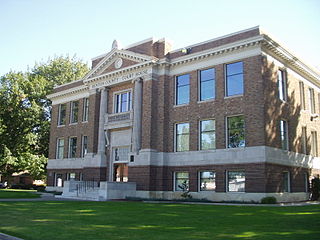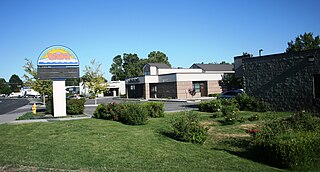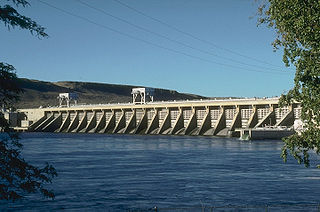
The Hanford Site is a decommissioned nuclear production complex operated by the United States federal government on the Columbia River in Benton County in the U.S. state of Washington. The site has been known by many names, including Hanford Project, Hanford Works, Hanford Engineer Works and Hanford Nuclear Reservation.

The Tri-Cities are three closely linked cities at the confluence of the Yakima, Snake, and Columbia Rivers in the Columbia Basin of Eastern Washington. The cities border one another, making the Tri-Cities seem like one uninterrupted mid-sized city. The three cities function as the center of the Tri-Cities metropolitan area, which consists of Benton and Franklin counties. The Tri-Cities urban area consists of the city of West Richland, the CDPs of West Pasco and Finley, as well as the CDP of Burbank, despite the latter being located in Walla Walla County.

Richland is a city in Benton County, Washington, United States. It is located in southeastern Washington state at the confluence of the Yakima and the Columbia Rivers. As of the 2010 census, the city's population was 48,058, with a 2019 estimate from the Census Bureau putting its population at 58,225. Along with the nearby cities of Pasco and Kennewick, Richland is one of the Tri-Cities, and is home to the Hanford nuclear site.

Benton County is a county in the south-central portion of the U.S. state of Washington. As of the 2010 census, its population was 175,177. The county seat is Prosser, and its largest city is Kennewick. The Columbia River demarcates the county's north, south, and east boundaries.

Pacific Northwest National Laboratory (PNNL) is one of the United States Department of Energy national laboratories, managed by the Department of Energy's (DOE) Office of Science. The main campus of the laboratory is in Richland, Washington.

Kennewick is a city in Benton County in the U.S. state of Washington. It is located along the southwest bank of the Columbia River, just southeast of the confluence of the Columbia and Yakima rivers and across from the confluence of the Columbia and Snake rivers. It is the most populous of the three cities collectively referred to as the Tri-Cities. The population was 73,917 at the 2010 census; the Census Bureau estimates the city's population to be 84,347 as of July 1, 2019.

West Richland is a city in Benton County, Washington, United States. The population was 11,811 at the 2010 census. The city is part of the Tri-Cities metropolitan area, whose principal cities are Richland, Kennewick, and Pasco.

Priest Rapids Dam is a hydroelectric, concrete gravity dam; located on the Columbia River, between the Yakima Firing Range and the Hanford Nuclear Reservation, and bridges Yakima County and Grant County, in the U.S. state of Washington. The dam is 24 miles south of the town of Vantage, and 47 miles northwest of the city of Richland. It is located at mile marker 397.1 from the mouth of the Columbia. It is owned by the Grant County Public Utility District (PUD). Priest Rapids, for which the dam was named, are now submerged beneath the dam's reservoir.

McNary Dam is a 1.4-mile (2.2-km) long concrete gravity run-of-the-river dam which spans the Columbia River. It joins Umatilla County, Oregon with Benton County, Washington, 292 miles (470 km) upriver from the mouth of the Columbia. It is operated by the U.S. Army Corps of Engineers' McNary Lock and Dam office. The dam is located a mile (2 km) east of the town of Umatilla, Oregon, and 8 miles (13 km) north of Hermiston, Oregon. The dam was originally planned to be named Umatilla Dam, but the Flood Control Act of 1945 renamed the dam in honor of Senator Charles L. McNary of Oregon, who had died the previous year.

A Quonset hut is a lightweight prefabricated structure of corrugated galvanized steel having a semi cylindrical cross-section. The design was developed in the United States, based on the Nissen hut introduced by the British during World War I. Hundreds of thousands were produced during World War II and military surplus was sold to the public. The name comes from the site of their first manufacture at Quonset Point at the Davisville Naval Construction Battalion Center in Davisville, Rhode Island.

The B Reactor at the Hanford Site, near Richland, Washington, was the first large-scale nuclear reactor ever built. The project was a key part of the Manhattan Project, the United States nuclear weapons development program during World War II. Its purpose was to convert natural uranium metal into plutonium-239 by neutron activation, as plutonium is simpler to chemically separate from spent fuel assemblies, for use in nuclear weapons, than is to isotopically enrich uranium into weapon-grade material. The B reactor was fueled with metallic natural uranium, graphite moderated, and water-cooled. It has been designated a U.S. National Historic Landmark since August 19, 2008 and in July 2011 the National Park Service recommended that the B Reactor be included in the Manhattan Project National Historical Park commemorating the Manhattan Project. Visitors can take a tour of the reactor by advance reservation.

Richland High School is a public secondary school in the northwest United States, located in Richland, Washington. The school was founded as Columbia High School in 1910 to serve the educational needs of the small town of Richland. The building was replaced with a much larger structure by the U.S. Army Corps of Engineers in 1946 as the development of the neighboring Hanford Engineering Works brought an infux of employees to the region to support the war effort.
Energy Northwest is a public power joint operating agency in the northwest United States, formed 64 years ago in 1957 by Washington state law to produce at-cost power for Northwest utilities. Headquartered in the Tri-Cities at Richland, Washington, the WPPSS became commonly known as "Whoops!", due to over-commitment to nuclear power in the 1970s which brought about financial collapse and the second largest municipal bond default in U.S. history. WPPSS was renamed Energy Northwest in November 1998, and agency membership includes 27 public power utilities, including 23 of the state's 29 public utility districts.
State Route 240 (SR 240) is a state highway in the U.S. state of Washington. It travels diagonally from northwest to southwest within Benton County, serving the Hanford Nuclear Reservation and the Tri-Cities region. The highway begins at a junction with SR 24 and travels around Richland on a limited-access bypass. From there, it briefly overlaps Interstate 182 (I-182) and continues southeast as a freeway along the Columbia River into Kennewick, terminating at an interchange with U.S. Route 395 (US 395). SR 240 is one of the busiest highways in the Tri-Cities region, with a daily average of 76,000 vehicles on a section crossing the Yakima River Delta.

Horn Rapids Dam is a rock filled timber crib barrage dam on the Yakima River in Benton County, Washington near the intersection of SR 240 and SR 225. The dam is not used for hydroelectric production, rather to fill irrigation canals on either bank of the river.

Columbia Park is a public park located in Benton County, Washington, United States. The park comprises the 400-acre (160 ha) Columbia Park East in Kennewick, and the adjacent 50-acre (20 ha) Columbia Park West in Richland. Together, the parks function as a single 450-acre (180 ha) park with 4.5 miles (7.2 km) of shoreline along the Columbia River. The park is a popular destination for residents of the Tri-Cities.

The 300 Area is part of the Hanford Site in the state of Washington, USA. The area was originally used for the production of fuel for nuclear reactors and for performing research on improving the production process, however most modern work being done focuses on environmental research. After a decade of demolition activities, the surplus 300 Area facilities, with the exception of the 324 Blg, have been torn down. Today, the few buildings that remain active are laboratories, workshops, and offices. It is operated by the Pacific Northwest National Laboratory.

The Gold Coast Historic District is a residential area in Richland, Washington, the town that was built during the World War II Manhattan Project to house workers at the Hanford atomic plant. The homes within the district date from 1948-49 and are associated with the Cold War expansion of plutonium manufacturing at the plant.
The Catalina Federal Honor Camp, or Tucson Federal Prison Camp, located in the Santa Catalina Mountains, held men subject to the World War II incarceration of Japanese Americans. It had no security fence, boundaries were marked with stones painted white. 45 of the 46 prisoners were draft resisters and objectors of conscience transferred from camps in Colorado, Arizona and Utah, although Gordon Hirabayashi, who had challenged the exclusion of Japanese Americans from the West Coast, was also held here.
The following is a timeline of the history of the Tri-Cities, an area of the U.S. state of Washington encompassing the cities of Kennewick, Pasco, and Richland.
















